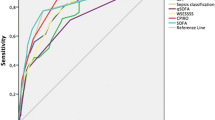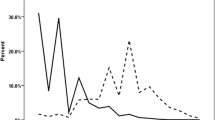Abstract
Background
Sepsis is common in surgical patients, and its presence influences the outcomes in those to undergo surgery. Factors such as advanced age, presence of comorbidities and many other conditions increase mortality in surgical patients with sepsis. The sequential organ failure assessment (SOFA) score simplified into qSOFA helps to define sepsis and to identify patients who are likely to die from it. Sepsis in surgery is under investigated in low- and middle-income countries and so are the factors for mortality in that specific surgical population. Our aim was to develop a prognostic tool accurate in predicting outcomes in surgical patients with sepsis who present at University Teaching Hospitals of Kigali (CHUK) and Butare (CHUB) and in other centers with limited resources
Methods
This was a prospective cohort study conducted over a period of 1 year from February 2018 to January 2019. The surgical patients with sepsis recruited in the first 6 months at CHUK served as the derivation cohort and those recruited in the next 6 months from both CHUK and CHUB served as the validation cohort. The Kigali surgical sepsis (KiSS) score was derived, and to determine its accuracy in predicting mortality, we measured sensitivity, specificity and area under receiver operator characteristic (AUROC) curve. We then compared this with qSOFA score.
Results
A total of 288 patients were recruited with 144 in each cohort. The mean age was 36.5, and median age was 32.6. The mean length of hospital stay (LoHS) was 22.9 days. The overall intensive care unit (ICU) admission rate was 51.4%, and the surgical sepsis-related hospital mortality rate was 21.7%. Factors associated with surgical sepsis-related hospital mortality were age above 55 years (p = 0.034), presence of comorbidities (p = 0.069), hypotension (p = 0.014), tachycardia (p = 0.061), tachypnea (p = 0.028), decreased level of consciousness (p = 0.021), presence of GIT perforation (p = 0.026) and number of impaired organ function (p = 0.035). A predictive score (KiSS score) consisting of six parameters was derived from these factors and compared to qSOFA score. The sensitivity of KiSS score in predicting mortality was 73% (vs 52% for qSOFA), and the specificity was 97% (vs 87% for qSOFA). The predictive validity for hospital mortality was assessed by AUROC curve, and it was 0.939 (95% CI, p < 0.001) for KiSS and 0.684 (95% CI, p < 0.001) for qSOFA.
Conclusion
The KiSS score was effective in predicting surgical sepsis-related hospital mortality in low-resource setting. The KiSS score showed an added advantage of stratifying septic surgical patients to be operated on into those with good, variable and poor prognosis.


Similar content being viewed by others
References
Singer M, Deutschman CS, Seymour C, Shankar-Hari M, Annane D, Bauer M et al (2016) The third international consensus definitions for sepsis and septic shock (sepsis-3). JAMA J Am Med Assoc 315(8):801–810
Artero A, Zaragoza R, Nogueira JM (2012) Epidemiology of severe sepsis and septic shock. In: Fernandez R (ed) Severe sepsis and septic shock - understanding a serious killer. InTech. http://www.intechopen.com/books/severe-sepsis-and-septicshock-understanding-a-serious-killer/epidemiology-of-severe-sepsis-and-septic-shock
Martin GS, Mannino DM, Moss M (2006) The effect of age on the development and outcome of adult sepsis. Crit Care Med 34(1):15–21
Moore LJ, Moore FA (2012) Epidemiology of sepsis in surgical patients. Surg Clin N Am 92(6):1425–1443. https://doi.org/10.1016/j.suc.2012.08.009
Mayr FB, Linde-zwirble WT, Peck-palmer OM, Barnato AE, Weissfeld LA, Angus DC (2014) Infection rate and acute organ dysfunction risk as explanations for racial differences in severe sepsis. JAMA 303(24):2495–2503
Korošec H, Jagodi K, Podbregar M (2006) Long-term outcome and quality of life of patients treated in surgical intensive care: a comparison between sepsis and trauma. Crit Care Med 10(5):1–7
Waitt PI, Mukaka M, Goodson P, SimuKonda FD, Waitt CJ, Feasey N et al (2015) Sepsis carries a high mortality among hospitalised adults in Malawi in the era of antiretroviral therapy scale-up: a longitudinal cohort study. J Infect 70(1):11–19. https://doi.org/10.1016/j.jinf.2014.07.004
Jacob ST, Moore CC, Banura P, Pinkerton R, Meya D, Reynolds SJ et al (2009) Severe sepsis in two Ugandan hospitals: a prospective observational study of management and outcomes in a predominantly HIV-1 infected population. PLoS One 4(11):e7782
Moore LJ (2010) Sepsis in general surgery. Arch Surg 145(7):695
Freund Y, Lemachatti N, Krastinova E, Van Laer M, Claessens YE, Avondo A et al (2017) Prognostic accuracy of sepsis-3 criteria for in-hospital mortality among patients with suspected infection presenting to the emergency department. JAMA J Am Med Assoc 317(3):301–308
Wang HE, Shapiro NI, Angus DC, Yealy DM (2007) National estimates of severe sepsis in United States emergency departments. Crit Care Med 35(8):1928–1936
Williams JM, Greenslade JH, McKenzie JV, Chu K, Brown AFT, Lipman J (2016) Systemic inflammatory response syndrome, quick sequential organ function assessment, and organ dysfunction. Chest 151(3):586–596. https://doi.org/10.1016/j.chest.2016.10.057
Gupta S, Rudd KE, Tandhavanant S, Suntornsut P, Chetchotisakd P, Angus DC, Peacock SJ, Chantratita N, West TE (2019) Predictive validity of the qSOFA score for sepsis in adults with community-onset staphylococcal infection in Thailand. J Clin Med 8(11):1908
Riviello ED, Kiviri W, Twagirumugabe T, Mueller A, Banner-Goodspeed VM, Officer L, Novack V, Mutumwinka M, Talmor DS, Fowler RA (2016) The Kigali modification of the Berlin definition: a new epidemiological tool for ARDS? J Thorac Dis 8(6):E443–E445. https://doi.org/10.21037/jtd.2016.03.84
Funding
This study did not receive any fund.
Author information
Authors and Affiliations
Corresponding author
Ethics declarations
Conflict of interest
The authors have no financial disclosures.
Additional information
Publisher's Note
Springer Nature remains neutral with regard to jurisdictional claims in published maps and institutional affiliations.
Rights and permissions
About this article
Cite this article
Niyongombwa, I., Sibomana, I., Karenzi, I.D. et al. Kigali Surgical Sepsis (KiSS) Score: A New Tool to Predict Outcomes in Surgical Patients with Sepsis in Low- and Middle-Income Settings. World J Surg 44, 3651–3657 (2020). https://doi.org/10.1007/s00268-020-05708-7
Accepted:
Published:
Issue Date:
DOI: https://doi.org/10.1007/s00268-020-05708-7




